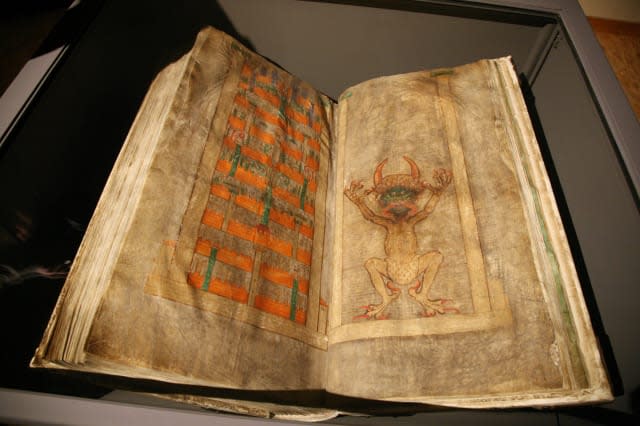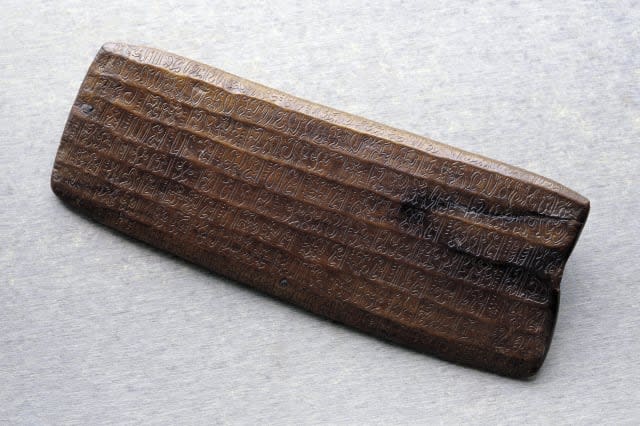Ten unexplained archaeological discoveries
Occasionally, archaeologists unearth items that leave even leading experts completely stumped.
From the Ancient Greek Antikythera Mechanism, known as the first ever computer, to the hundreds of mysterious stone spheres scattered across Costa Rica, here are 10 of the most bizarre and perplexing discoveries from history.
See also: The creepiest places in the world
See also: Inside the bizarre Crazy House hotel in Vietnam
10 The Devil's Bible

This is an object surrounded by myth and mystery. Legend has it that the text was written by a 12th century monk on the orders of the devil. The monk supposedly wrote the book in a single night and Satan marked it with a portrait of himself. It's estimated that such a manuscript, which was written on more than160 animal skins and requires two people to lift, would have taken approximately 30 years to write. But the consistency of the handwriting suggests that the bible was written by one person over a short period of time.

9. The Piri Reis Map
Discovered in 1929, this curious map was written in 1513 by Piri Reis, an admiral of the Turkish navy. The map shows Europe, North Africa, the coast of Brazil and even Antarctica - although it's thought that the continent wasn't discovered until more than 300 years later. Mysteriously, the map describes Antarctica's features in meticulous detail, including areas that have been covered in ice for the past 6000 years. Scientists are baffled as to how Reis had been able to map out the landscape beneath the ice as accurately as he did.
8. The Antikythera Mechanism

This has been dubbed as the 'first computer' and it is a clock like machine that was discovered near the Greek island of Antikythera in 1902. The 2000 year old instrument is believed to have been used by Ancient Greek scientists to predict astronomical positions. the design is so complex that it has forced a re-evaluation of our understanding of ancient engineering capabilities. Bizarrely there is no mention of the mechanism in contemporary documentation and no earlier prototypes have been discovered.
7. The Rongorongo Writing

Believed to be an early form of writing, the Rongorongo glyphs are a series of wooden carvings that were discovered in 1864 on Easter Island. Despite several attempts by experts, nobody has been able to decipher the meaning of the symbols. If the cryptic symbols do turn out to be writing then they would constitute one of only three of four times when humans independently developed systems of writing. It's thought that if the meaning of the glyphs could be found then it may explain what happened to the early civilisation on Easter Island.
6. Baghdad Battery
This is a ceramic pot that was found near Baghdad in Iraq, along with a metal rod and a tube. It was speculated that it may have been used for coating silver objects with gold, through a process called 'electroplating'. Modern experiments on replicas of the vase show that this would have been theoretically possible. As the items have been dated to between 250BC and 224AD, the existence of such technology could evidence an understanding of electricity much earlier than previously thought.
5. Roman Dodecahedrons

First reported in the early 18th century, 116 dodecahedral Roman artifacts have been discovered in various locations ranging from Wales to Hungary. The bizarrely shaped objects are all made of either bronze or stone and range from 4cm to 11 cm in size. There is a great deal of mystery surrounding what the objects can have been used for. Many were found in temples suggesting they may have some religious significance.
4. The Longyou Grottoes

The Longyou Grottoes are a series of manmade caves in China, which date back to 212BC. They cover a massive 30,000 square metres and include a series of rooms, bridges and pools. Their discovery in 1992 presented one of the largest underground excavations ever. Archaeologists, engineers, historians and geologists have all investigated the grottoes but no one has any idea how they were constructed. It's been estimated that it would have taken 1,000 people working day and night for six years to complete the caves.
3. Yonaguni Monument

The Yonaguni Monument is an underwater pyramid-shaped structure that was discovered off the coast of Japan in 1986. Leading experts disagree on whether the structure is man made or a natural rock formation. One professor claims the steps and columns suggest the structure was man made but others argue that water erosion and earthquakes could have also caused these shapes to form.
2. Costa Rica Stone Spheres

Ranging in diameter from a few centimetres to over two and a half metres, these perfect stone spheres are among the world's most famous unexplainable discoveries. They were first noted in the 1940s and since then more than 300 have been found scattered throughout the Costa Rican jungle. They date back to between 500 and 1500 BC and no one knows what they were made for. One theory suggests they may relate to astrological alignments, but as most of the stones have now been moved it's hard to see if this is true or not.
1. The Sewer of Babies
In 1988 archaeologists excavating an Ancient Roman sewer under a bathhouse in Ashkelon, Israel made a haunting discovery - the skeletons of nearly 100 newborn babies. None of the bodies showed evidence of disease or skeletal malformation, implying that they had not died of natural causes. Due to the regularity of female infanticide initial suspicions were that the sewers had been used as a mass grave for unwanted daughters. But it was later discovered that a large proportion of the bones belonged to boy babies, leaving archaeologists stumped.





